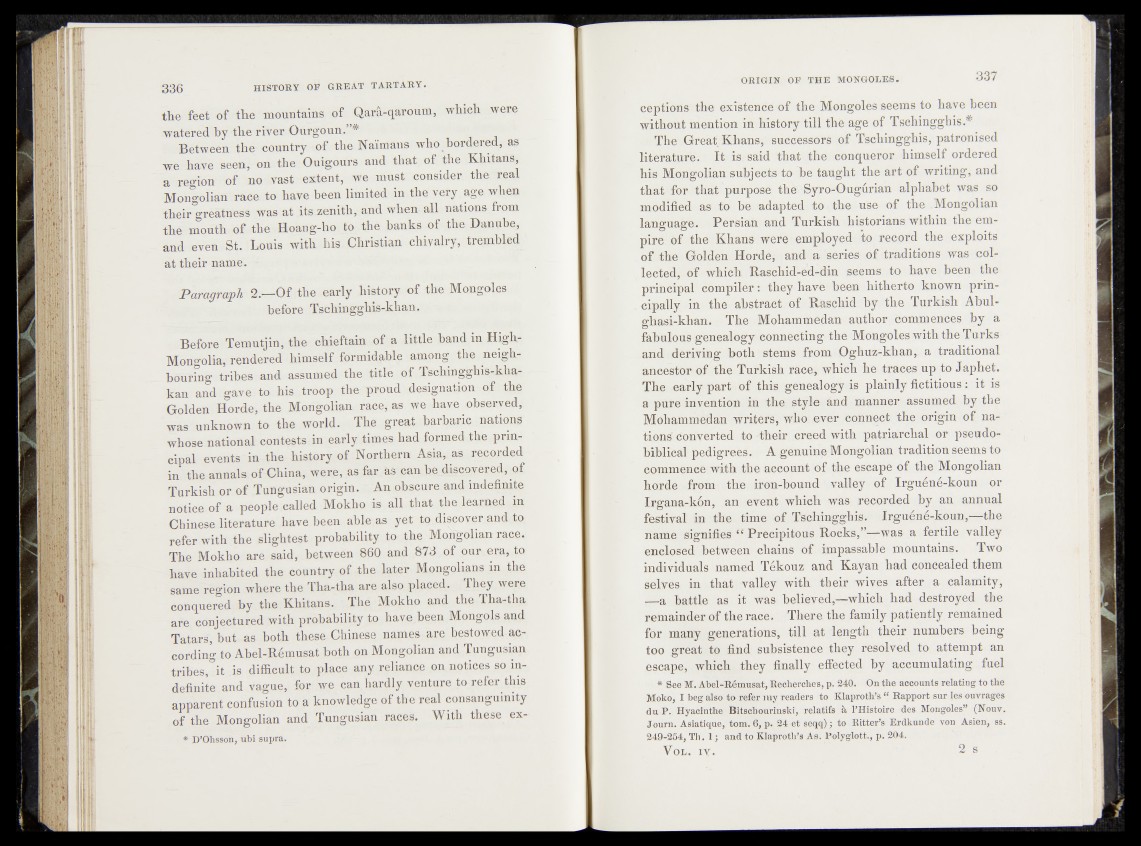
the feet of the mountains of Qarâ-qaroum, which were
watered by the river Ourgoun.”*
Between the country of the Naïmans who bordered, as
we have seen, on the Ouigours and that of the Khitans,
a region; of no vast extent, we must consider the real
Mongolian race to have been limited in the very, age when
their greatness was at its .zenith,- and when all nations from
the mouth of the Hoang-ho to the banks of the Daniibe,
and even St. Louis with his Christian chiy.alry, trembled
at their name. -
Paragraph 2.—Of the early history of the Mongoles
before Tschingghis-khan.
Before Temutjin, the chieftain of a little hand in Highr
Mongolia, rendered himself formidable among the. neighbouring
tribes and assumed the title of Tschingghis-kha-
kan and gave to his troop the proud designation of the
Golden Horde, the Mongolian race, as we ha.vfe ^observed,
was unknown to the world. The great barbaric .nations
whose national contests.in early times had formed the principal
events in the history of Northern
in the annals of-China, were, as far as canbejdisçqyeçediiôf
Turkish or of Tungusian origin. An obscure anddndefinite
notice of a people called Mokho is all that the.learned in
Chinese.literature have been able as yet to discover and,to
refer with the slightest probability to the Mongolian race..
The Mokho are said, between 800 and 873 . of our. era, to
have inhabited the country of the later Mongolians in the
same region where the Tha-tha are also placed. They wer.e
conquered by the Khitans. Thé Mokho and the Tha-tha
are conjectured with probability to have.been Mongols and
Tatars, but as both these Chinese names-are bestowed according
to Abel-Rémusat both on Mongolian and Tungusian
tribes,, it.is difficult to place any reliance on notices so indefinite
and vague, for we can hardly venture to refer .tips
apparent confusion to a knowledge of the real consanguinity
of the Mongolian and Tungusian racés. With these ex-
* D’Ohsson, ubi supra.
ceptions the existence of the Mongoles seems to have been
without mention in history till the age of Tschingghis.#
The Great Khans, successors of Tschingghis, patronised
literature. It is, said that the conqueror himself ordered
his Mongolian subjects to be taught the art of writing, and
that for that purpose1 thè^Syro-Ougürian alphabet was so
modified as to be adapted to the use of the Mongolian
language. Persian and Turkish historians within the empire
of the Khans were employed to record the exploits
of the Golden Horde, and a series of traditions was collected,
of which Raschid-ed-din seems to have? been the
principal' compiler: they have* been hitherto known principally
in the abstract, of Raschid by the Turkish Abul-
gliasi-khan. The Mohammedan author commences by a
fabulous genealogy connecting the Mongoles with the Turks
and deriving both stems from Oghuz-khan,. a traditional
ancestor of the Turkish race, which he traces u.p to Japhet.
The early part of this genealogy is plainly fictitious^:it is
a pure invention^®. the? style1- and manner assumed. b,y the
Mohammedan writers, w®l|eVer com^ct &h<|f$rigin of nations*
Converted to-their .creed with, patriarchal ©Pijppeudo-
biblical pedigrees. A genuine. M ongolian tradition seems to
commence with the account of the escape of the Mongolian
horde from the iron-bound valley of Irguéné-koun or
Irgana-k6n, an event which wns recorded by an annual
festival in the time of Tsddngghi^ fi Irguéhé-fioun,—the
name signifies £C Precipitous Rocks,”h-was a fertile vaRey
enclosed between chains of impassable mountains. Two
individuals named Tékouz and Kayan had eopeealed them
selves in that walley with their wivpS] after a calamity,
—a battle as it was believed^whicli had destroyed the
remainder of the race. There the family patiently remained
for many generations, till at length their numbers being
too great tp find subsistence they resolved to attempt an
escape, which they finally effected by accumulating fuel
* gee M. Abel-Rémusat, Récherches, p. 240. Oh the accounts relating to the
Moko, I beg also to refer my readers to Klaproth’s “ Rapport sur les ouvragés
dït-P. Hyacintbe Bitschourinski, relatifs: A l’Histeire des Mongoles” (ifout.
Journ. Asiatique, tom. 6, p. 24 et-seqq); to Ritter’s Erdkunde von Asien, ss.
249-254, Th. 1; and to Klaproth’s As. Polvglott., p. 204.
VOL. 1Y. ' Ê I